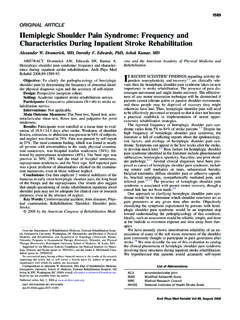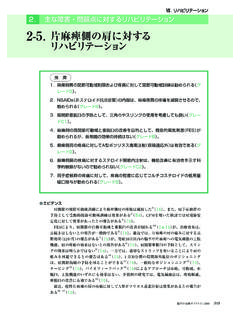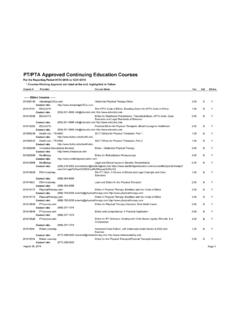Transcription of Upper Limb Treatment Schedule Booklet - ACPIN
1 Upper limb Treatment Schedule Booklet : to accompany the Upper limb Treatment Recording Form Centre for Rehabilitation and Ageing Department of Geriatric Medicine Clinical Developmental Sciences St George s Hospital Medical School University of London Contents page Background 3 Introduction 3 The Recording Form 4 Instructions of how to use the Recording Form 5 Examples of equipment used 5 Examples of specific Treatment activities 6 Examples of materials used for Splinting 8 Glossary of Terms used in the Recording Form 10 References 10 Background There is strong evidence that stroke unit care
2 Improves outcomes for patients but many still report an enormous problem in using their weaker arm and hand. Some small studies have been carried out which have looked at different types of physiotherapy. To date, however, the use of research findings in stroke rehabilitation has been hampered by a lack of description of conventional physiotherapy and by a lack of research conducted with sufficient subjects to be confident in the results. This form has been produced as a way of recording the content of physiotherapy Treatment for patients presenting with Upper limb impairment after stroke. This information may then be incorporated into research projects investigating different types of physiotherapy intervention.
3 Audiotaped interviews with senior neuro physiotherapists were carried out to produce a Treatment list. This was comprised of: aims of Treatment , gross positions of the patient, equipment used, setting for Treatment , and actual Treatment activities provided. A Treatment recording form was produced from this which has been piloted in clinical practice. The recording form and this accompanying Booklet constitute, the Upper limb Treatment Schedule . Introduction This Upper limb Treatment Schedule has been produced for patients, undergoing Treatment by a qualified physiotherapist, following a stroke. It has been produced after interviews and extensive discussion with Senior Neuro-physiotherapists in and around the South London area.
4 The aim of the form is to represent conventional physiotherapy practice for the Upper limb after stroke but it is appreciated that not every Treatment may have been included. Feedback would be welcomed should this be the case. Please note that this form has not been developed for those who present with neglect or inattention. We hope that you will find this a user-friendly and concise tool, but if you have any queries or experience any difficulty, please do not hesitate to contact: Catherine Donaldson, Centre for Rehabilitation and Ageing, Geriatric Medicine, Department of Clinical Developmental Sciences, St George s Hospital Medical School, University of London, Cranmer Terrace, London SW17 0RE.
5 Instructions for completion of Upper limb Treatment Recording Form Please note that this Treatment Schedule is not suitable for patients demonstrating neglect. 1. ONE FORM FOR EACH Treatment SESSION Please complete one form for each patient contact with subjects in the Functional Strength Training Upper limb Clinical Trial. If the Treatment session has not involved the Upper limb , a 0 should be placed in the Est duration of Upper limb Rx section. 2. TO COMPLETE THE AIMS SECTION Please place a tick in the box that best describes the aims relevant to the particular Treatment session being recorded. Unless stated otherwise, it is assumed that the aim is to Improve/ Optimise in each case.
6 3. TO COMPLETE THE GROSS POSITION SECTION Place a tick in the box for every gross position used to deliver physiotherapy Treatment during Treatment sessions being recorded. Forward lean sitting should be documented as supported sitting . 4. TO COMPLETE THE EQUIPMENT SECTION Please write the name of any equipment used during the particular Treatment session being recorded. Please refer below (page 5) for further details of equipment. 5. TO COMPLETE THE SECTION Treatment ACTIVITIES Please place a tick in the boxes which best describe the Treatment that was given to the patient during the particular Treatment session being recorded.
7 6. FOR FURTHER DESCRIPTION OF ITEMS ON RECORDING FORM: Please refer to page 6 for Examples of Specific Treatment Activities 7. COMPLETED FORMS GIVEN TO RESEARCH TEAM Completed forms will be collected weekly by Catherine Donaldson (Researcher conducting the FST clinical trial) Examples of equipment used Air inflated supports Pens/ pencils Ball Pillows Balloon Plinth Beads, Sandbag Bed Sensory box Chairs Small ball Coins Table / high table Comb / hairbrush Tennis ball, football Theraband Games: (Jenga, dominos, chess, draughts, cards, jigsaw puzzles) Toothpaste, deodorant Gymball Towels Jug Upper limb bike Multigym Wedge Parallel bars Examples of Specific Treatment Activities 1.
8 Soft tissue mobilisation * * see References page 11 Stroking For example: the therapist places the whole of their hands in contact with the skin and maintains a gentle but firm pressure and draws the hands towards them. The strokes overlap each other Effleurage For example: rhythmical, sweeping, strokes moving distally to proximally over the Treatment area Lymph drainage techniques For example:short, light rhythmical strokes, which are non-gliding in the direction of lymphatic flow Petrissage (kneading/wringing/ picking-up/ rolling) For example: compression of superficial tissue, muscles or ligaments where the tissue is compressed, then lifted, squeezed or rolled, and taken to the tissue end-feel.
9 Specific compression (trigger points) For example localised pressure to relieve muscle spasm for example over subscapularis, and Upper trapezius Myofascial release Non-gliding traction and stretch to produce a sustained tensional force on the muscle and its associated fascia, which results in viscoelastic lengthening of the fascia Frictions For example: the therapist places the tip of their thumb or finger over the structure to be treated and performs small rotary movements whilst maintaining a constant pressure. There is no glide on the skin and the superficial tissues are moved on the underlying structures. 2. Joint mobilisation Accessory movements For example: Therapist s hands cupping the scapula and mobilising the scapula into protraction/ retraction with Upper limb de-weighted.
10 Distraction/ compression to the gleno/humeral joint with therapist stabilising scapula/ shoulder girdle with one hand, whilst the other hand supports the head of humerus. Antero-posterior / postero-anterior mobilisations to the radial head to increase supination Passive movements For example: Patient sits on plinth with therapist behind on gymball. The patient s arms in abduction and Elbow Flexion over the therapists knees. The therapist moves on the gymball to increase mobility at the shoulder girdle and trunk Graded small displacement activity to shoulder girdle, gleno/humeral joint, elbow, wrist, hand Active movements For example: Pendulum exercises in prone standing using targets on the floor ( cones) 3.









